A South Indian breakfast – Rava Dosa, is very popular throughout India and in many other countries too. It is really easy to make at home. It doesn’t require grinding or fermentation like regular dosa.
Learn to make a restaurant-style porous, thin, and perfectly crisp textured Rava Dosa recipe at home with this step-by-step recipe post. Once you try this recipe, you will make it again and again.
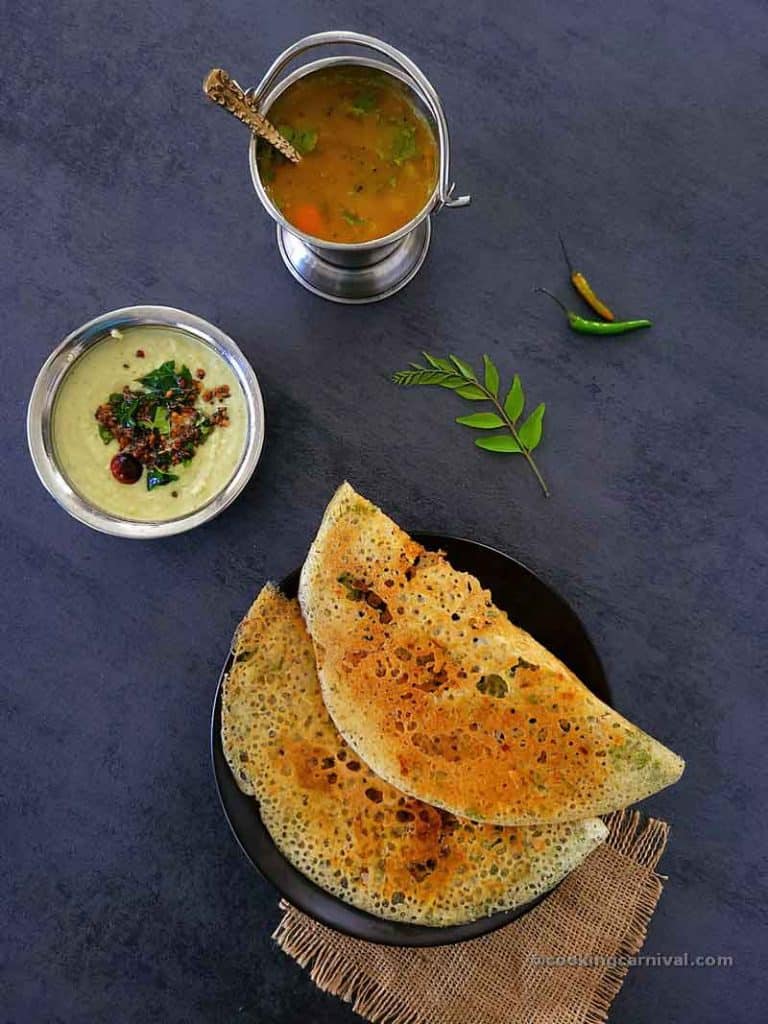
I am a huge fan of dosas. Some of my favorites are Adai dosa, Mung dal dosa, Instant dosa, Regular dosa, quinoa dosa and Rava dosa.
Today, I am sharing Rava dosa recipe with you all wonderful people. 🙂
What is Rava Dosa?
Rava dosa is a savory crepe made with Rava also known as sooji or semolina.
It is one of the quick South Indian breakfast recipes.
Unlike other dosa recipes, Rava Dosa (also known as sooji dosa) doesn’t require fermentation and grinding. This can be prepared instantly in just less than an hour.
Just mix all the ingredients (suji, rice flour, maida, onions, ginger, green chili, cilantro, salt, water, etc.) and let it rest for 20 minutes.
Isn’t it really simple!?
The batter has to be thin and be poured on the hot tawa with a ladle all around. Sometimes, I also pour the batter with my hands. Both the method gives the dosa net-like pattern.
While this dosa recipe is super easy to make, making it thin, netted and crispy does need some tips. I have shared all the tips at the end of the post as well as in the recipe card. Please read those carefully before making it to get restaurant-style Rava dosa.
This dosa is usually served with coconut chutney and sambar. You can also fill the dosa with potato masala. That will make it a more filling meal.
Why I love this recipe?
- Requires only a handful of ingredients
- Crisp, simple, and easy to make.
- Perfect any time of the day, be it breakfast, lunch, snack, or light dinner.
- Loved by all ages
Ingredients required
- Rava – Fine variety rawa works great in this recipe. You can use upma rava too.
- All-purpose flour – You can substitute it with whole wheat flour but the taste and texture will be slightly different.
- Rice flour – It helps in getting a crisp texture.
- Liquid – I have used water to make the batter. You can even use curd or buttermilk instead of water to make the thin batter.
- Oil/Ghee – Don’t skimp on oil or ghee. It won’t get you good results. Each hole on the dosa should be oiled to get the perfect texture.
- Whole spices – I love to add cumin seeds and black pepper in making this instant dosa. It gives a very nice and earthy flavor to the dosa. My family is not a big fan of whole black pepper, so I always coarsely crush it and use it in the recipe.
- Aromatics – I have used few aromatics in this recipe like ginger, green chilies, and finely chopped onions. If you are making this recipe Jain, skip the ginger and onions.
- Herbs – herbs like cilantro and curry leaves are used in this recipe to give fresh flavors.
- On top of the above ingredients, you will also need salt.
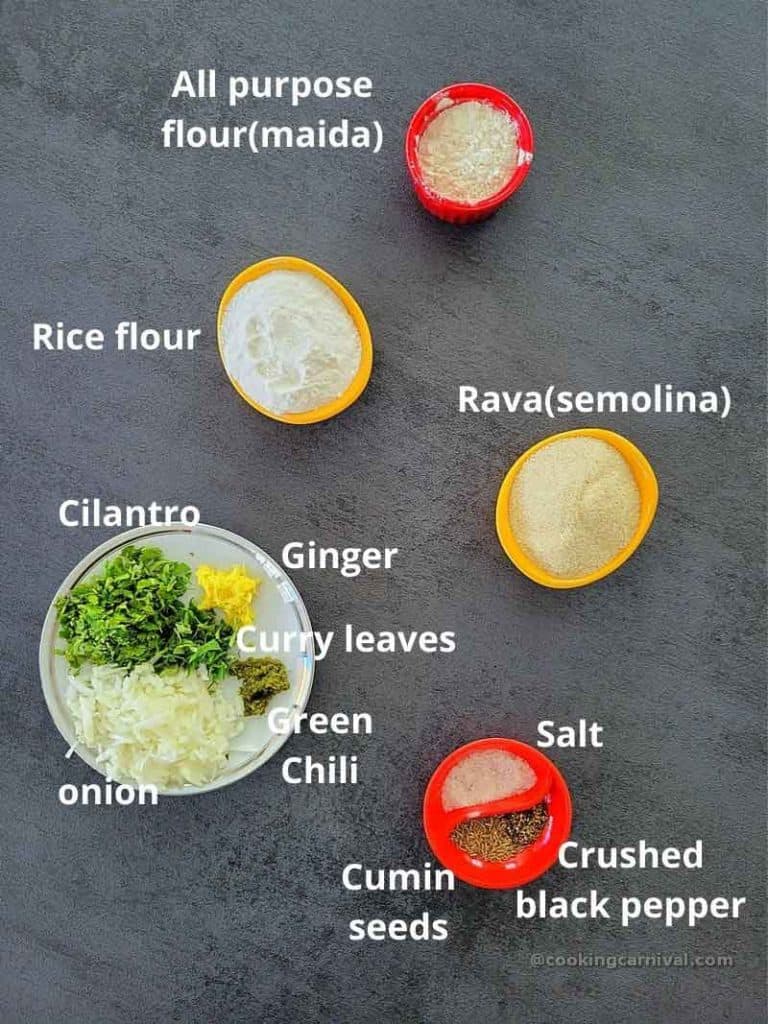
How to make this recipe? Step by step process –
Take Rava (sooji/semolina), rice flour, and all-purpose flour (maida) in a large bowl
Add chopped onion, green chili, ginger, finely chopped curry leaves, chopped cilantro, cumin seeds, coarsely crushed black pepper, and salt. Mix well.
Start adding water, little by little. Mix the batter well.
I added around 3 cups of water. Mix until you get a very thin batter and there are no lumps. The consistency of the batter should be very thin like buttermilk. Cover and let the batter sit for 20-30 minutes.
Once the batter is rested, stir the batter well. check the consistency and add water if required. My batter was perfect so I didn’t add more water. You may need more or less depending on the quality of Rava that you use.
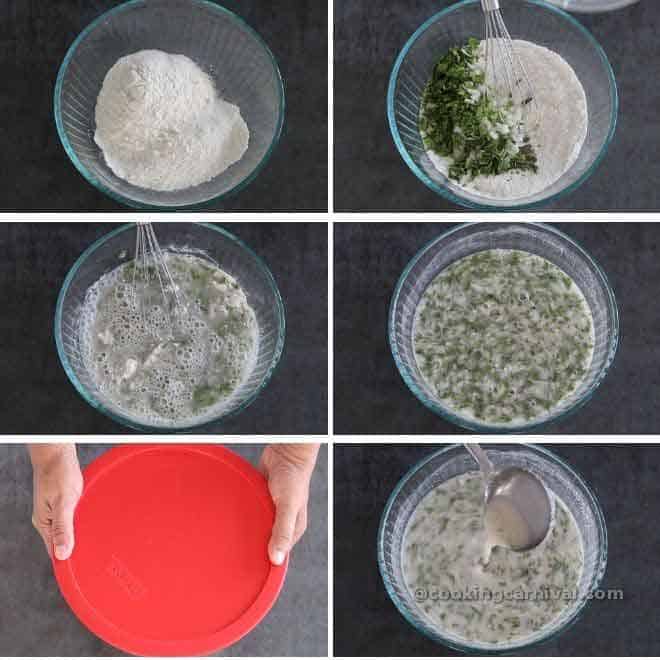
Heat an iron tawa on medium heat. Let it heat up nicely and then sprinkle some water and wipe it with some oil.
Take a ladle full of batter and start pouring it over the tawa, starting from the edges and then move to the center. Do not pour at one spot multiple times. You want it to be a as thin layer as possible.
You do not need to make a completely round shape like traditional dosa. MOST IMPORTANT is – don’t try to fill the small holes. You can fill the big and large holes by dropping the batter. This will give the dosa its lacy pattern.
Now reduce the heat to low-medium.
Drizzle oil, around the edges and also on top of the dosa.
Let the dosa cook on low-medium heat until it turns golden brown and crisp from the bottom.
Cooking rawa dosa on low to medium heat is important. It will take time but worth it. For me, It took about 10 to 12 minutes.
Once it’s golden brown from the bottom, gently remove it from the tawa and fold. Since this dosa is super thin, you don’t cook on the other side.
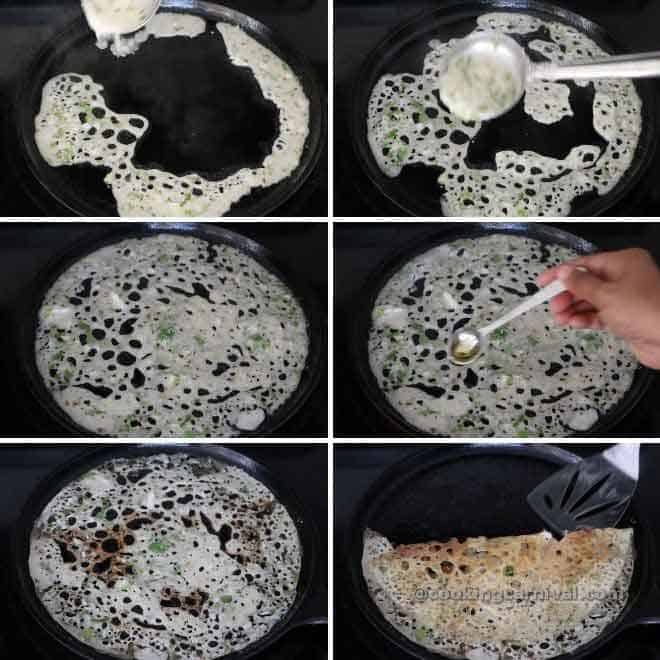
Make all dosa the same way with the remaining batter. Since Rava settles at the bottom, make sure to stir the batter every time you make dosa. You might need to add additional water as you make the dosa if the batter starts getting thick.
Serve crispy Rava dosa with coconut chutney and sambar! Enjoy!!
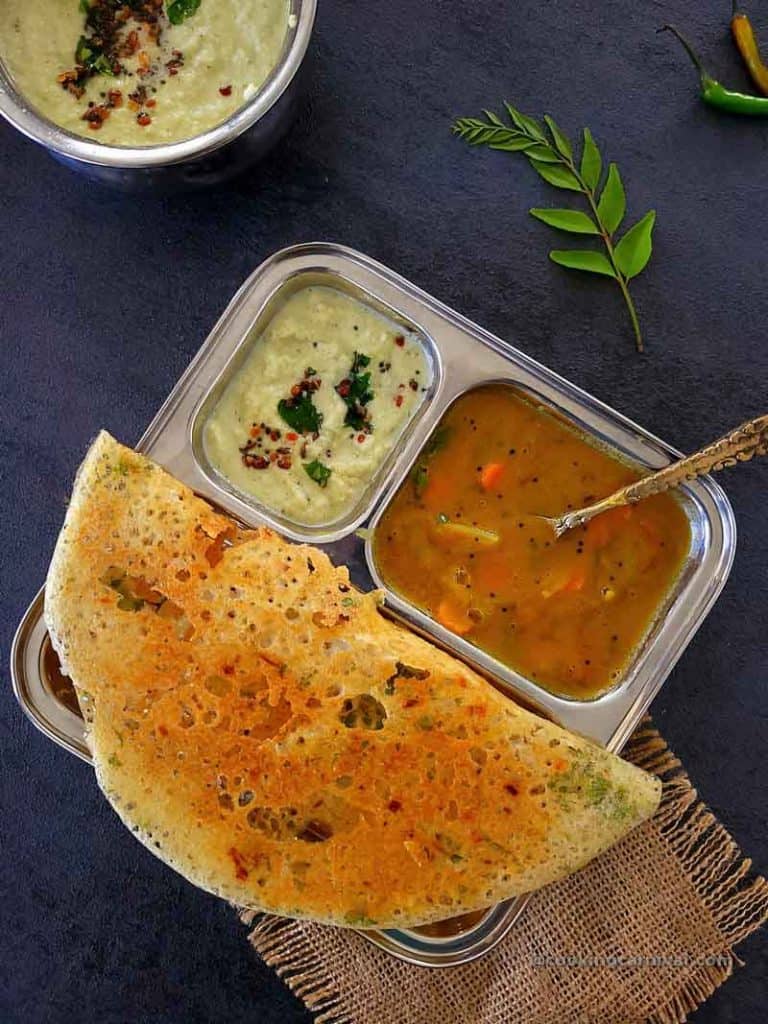
Important notes
- Ingredient Measurements
This is one savory recipe where measurements are really important.
2. Chop herbs, onion, and ginger finely
Chopping onion, cilantro, curry leaves finely are really important. Big pieces won’t cook well and won’t look nice in the outcome.
3. Soaking the batter
Before making dosa, always allow the batter to soak for 30 minutes. But make sure you don’t let the batter rest for long. The longer the batter rests, the thicker it gets and there is a chance of the dosa will not come out thin and crisp. Then it will not create lacy patterns. If by chance you let the batter for too long, make sure to adjust the consistency by adding water.
4. Consistency of the batter
The batter has to be thin and pourable. It is really important to get the perfect texture of the dosa. Runny and thin batter creates a porous, lace-like texture in the dosa. If the batter is of medium consistency, the Rava dosa will be soft and not crisp.
5. Pouring batter
The method of spreading Rava dosa batter on tawa is different than regular dosa. In regular dosa, the batter is spread on the tawa, whereas in rawa dosa, it has to be poured from the slightly more height. It gives the netted effect on the instant Rava dosa.
When pouring the batter, pour from the edges first and then move towards the center. Don’t pour too much better in one place, plus do not keep pouring the batter at one spot over and over again. And also don’t try to fill all the gaps as you pour the batter, you want it to be thin.
6. Cooking time
Rava dosa takes more time to cook than the regular dosa. First heat the pan on medium heat. Once it’s nicely heated, lower the heat to low, pour the batter and let the dosa cook until you see it turning golden brown.
This takes few minutes on low heat. Do not try to flip or remove the dosa from the pan until you see it browned from the sides and the center.
7. Mix the batter before making every dosa
As the rava tends to settle down at the bottom of the batter, every time before pouring the batter on tawa, mix the batter very well.
8. Use the right kind of pan
Always use a heavy or a thick bottomed iron tawa or pan, so that the rava dosa does not stick to the pan and comes out crisp. It is really important to use a cast iron pan to make this dosa. Cast iron pan retains heat for longer and helps to get the perfect texture.
Sure you can make it on a non-stick pan and it will come out good. But you will get them as a crisp result as with cast iron pan. So, if you are ok with a soft texture and don’t care about the crispiness, you are more than welcome to use a non-stick pan. But if you want a super crispy restaurant like rava dosa, please use an iron tawa.
9. This rava dosa recipe can also be halved or doubled or tripled.
10. You can add vegetables too like grated carrots, finally chopped bell pepper etc. in the batter.
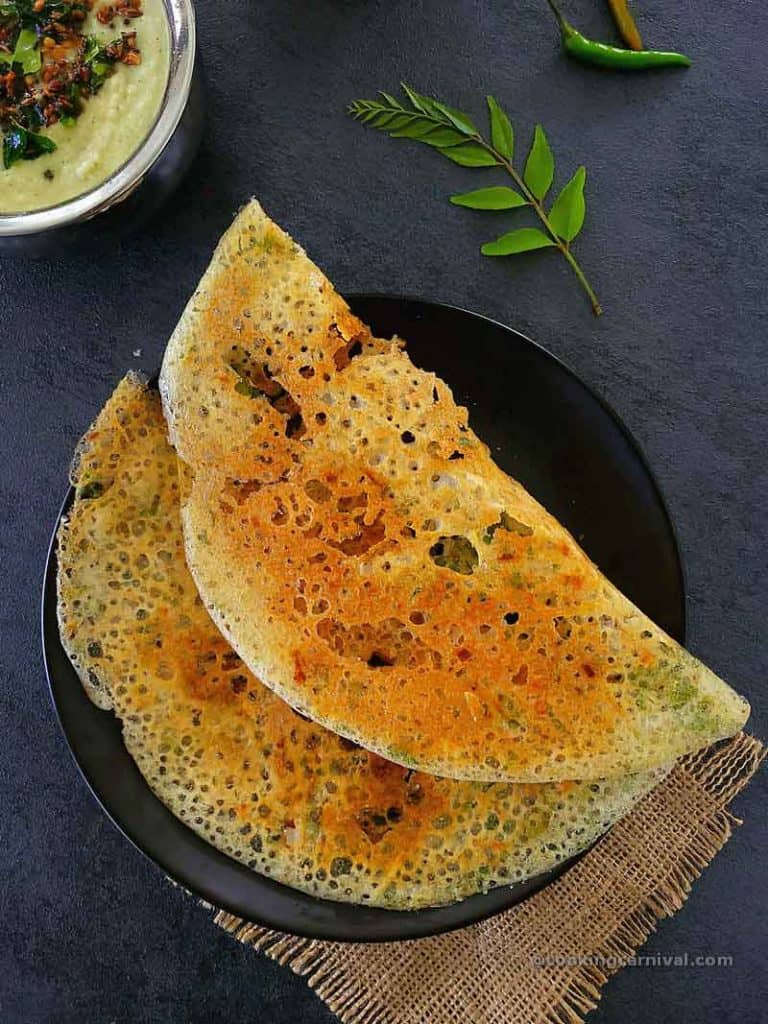
Some more Chutney recipes that can be served with dosa
Have you tried this Recipe? Please feed us with your feedback, ★ star ratings, and comments below.
You can also FOLLOW me on FACEBOOK, INSTAGRAM, and PINTEREST for more fabulous recipes and updates.
Subscribe to our YouTube Channel for tasty and easy video recipes.
Rava dosa (Suji Ka Dosa)
Ingredients
- ½ cup Rava / Sooji / Semolina
- ¼ cup All-Purpose Flour (maida)
- ½ cup Rice flour
- 1 teaspoon Ginger, grated (You can use paste or finely chopped ginger)
- ¼ cup finely chopped onion
- 2 tablespoon finelly Chopped cilantro
- 1 teaspoon Green chili paste
- 1 tablespoon Chopped curry leaves
- 1 teaspoon Jeera/cumin seeds
- 1 teaspoon Coarsely crushed black pepper
- salt to taste
- Oil or ghee as needed
Instructions
- Take Rava (sooji/semolina), rice flour, and all-purpose flour (maida) in a large bowl
- Add chopped onion, green chili, ginger, finely chopped curry leaves, chopped cilantro, cumin seeds, coarsely crushed black pepper, and salt. Mix well.
- Start adding water, little by little. Mix the batter well.
- I added around 3 cups of water. Mix until you get a very thin batter and there are no lumps. The consistency of the batter should be very thin like buttermilk. Cover and let the batter sit for 20-30 minutes.
- Once the batter is rested, stir the batter well. check the consistency and add water if required. My batter was perfect so I didn’t add more water. You may need more or less depending on the quality of Rava that you use.
- Heat an iron tawa on medium heat. Let it heat up nicely and then sprinkle some water and wipe it with some oil.
- Take a ladle full of batter and start pouring it over the tawa, starting from the edges and then move to the center. Do not pour at one spot multiple times. You want it to be a as thin layer as possible.
- You do not need to make a completely round shape like traditional dosa. MOST IMPORTANT is – don’t try to fill the small holes. You can fill the big and large holes by dropping the batter. This will give the dosa its lacy pattern.
- Now reduce the heat to low-medium.
- Drizzle 1 teaspoon oil or ghee, around the edges and also on top of the dosa.
- Let the dosa cook on low-medium heat until it turns golden brown and crisp from the bottom.
- Cooking rawa dosa on low to medium heat is important. It will take time but worth it. For me, It took about 10 to 12 minutes.
- Once it’s golden brown from the bottom, gently remove it from the tawa and fold. Since this dosa is super thin, you don’t cook on the other side.
- Make all dosa the same way with the remaining batter. Since Rava settles at the bottom, make sure to stir the batter every time you make dosa. You might need to add additional water as you make the dosa if the batter starts getting thick.
- Serve crispy Rava dosa with coconut chutney and sambar! Enjoy!!
Video
Notes
- This is one savory recipe where proper measurements are really important.
- Chopping onion, cilantro, curry leaves finely are really important. Big pieces won’t cook well and won’t look nice in the dosa.
- Before making dosa, always allow the batter to soak for 30 minutes.
- The batter has to be thin and pourable. If the batter is of medium consistency, the Rava dosa will be soft and not crisp.
- The batter has to be poured from slightly more height. It gives the netted effect on the instant Rava dosa.
- When pouring the batter, pour from the edges first and then move towards the center.
- Don’t pour too much better in one place.
- Rava dosa takes more time to cook than the regular dosa. So be patient.
- As the rava tends to settle down at the bottom of the batter, every time before pouring the batter on tawa, mix the batter very well.
- Always use a heavy or a thick bottomed well-seasoned iron tawa or pan, so that the rava dosa does not stick to the pan and comes out crisp. It is really important to use a cast iron pan to make this dosa. Cast iron pan retains heat for longer and helps to get the perfect texture.
- Sure you can make it on a non-stick pan and it will come out good. But you will get them as a crisp result as with cast iron pan. So, if you are ok with a soft texture and don’t care about the crispiness, you are more than welcome to use a non-stick pan.
- This rava dosa recipe can also be halved or doubled or tripled.
- This recipe is updated with a new images and video, originally published in 2015.
Nutrition
Warm regards,
Dhwani.

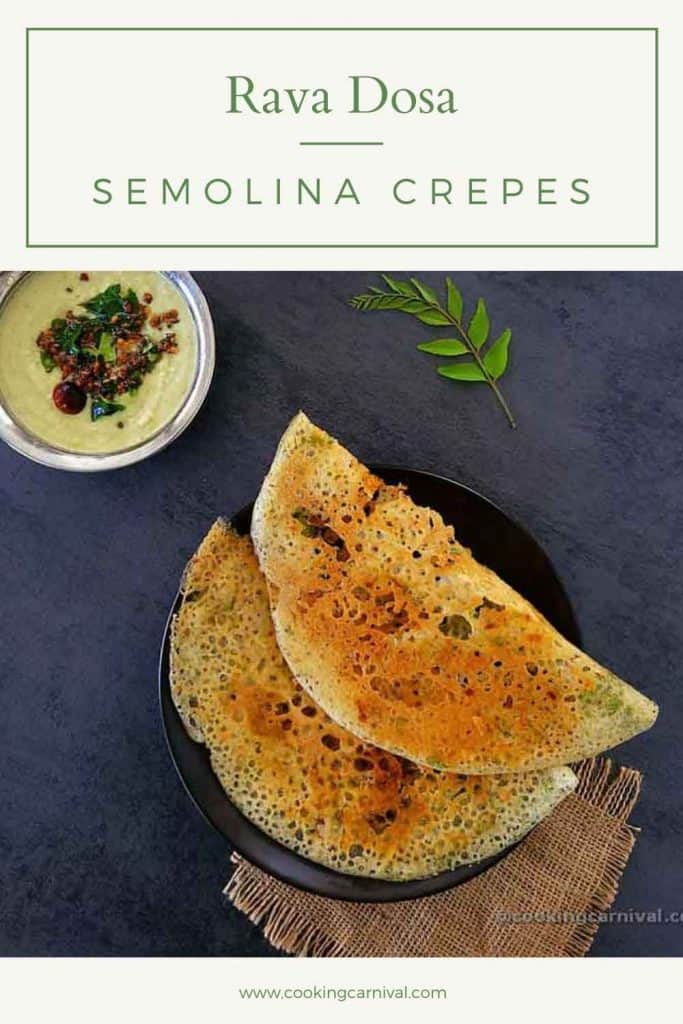

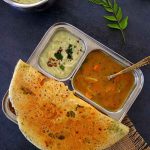
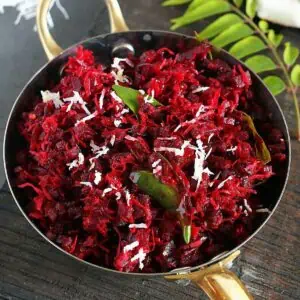

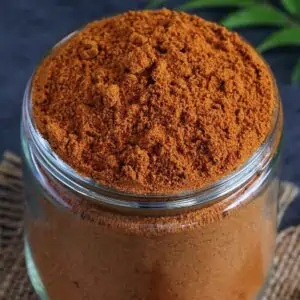
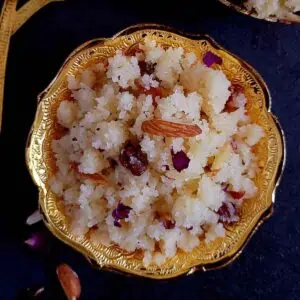

Thanks for this dosa receipe
I tried it and gets a lot of praise from my husband and kids and other family members
its very yummy and crispy
Hi Varuna!!!
Thanks dear for trying this recipe and sharing your valuable feedback. 🙂
How much water should u add? Thanks.
Hi Nancy!!!!
Water is 2 1/2 cup water for 1 cup of Rava/sooji or until you get very runny consistency of dosa batter.
Dear Dhwani wht if we dont wanna use APF.flour..any substitute?
Hi Nikita…
You can substitute it with whole wheat flour. Never tried though.Or skip APF. thanks.
I was waiting for this recipe. Thanks
Hi dhwani
This is a very nutritious breakfast….. But as I don’t eat rice… Can I add rawa to the gram to make it